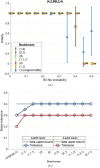Error mitigation in brainbox quantum autoencoders
- PMID: 39824994
- PMCID: PMC11748736
- DOI: 10.1038/s41598-024-84171-z
Error mitigation in brainbox quantum autoencoders
Abstract
Quantum hardware faces noise challenges that disrupt multiqubit entangled states. Quantum autoencoder circuits with a single qubit bottleneck have demonstrated the capability to correct errors in noisy entangled states. By introducing slightly more complex structures in the bottleneck, referred to as brainboxes, the denoising process can occure more quickly and efficiently in the presence of stronger noise channels. Selecting the most suitable brainbox for the bottleneck involves a trade-off between the intensity of noise on the hardware and training complexity. Finally, by analysing the Rényi entropy flow throughout the networks, we demonstrate that the localization of entanglement plays a central role in denoising through learning.
© 2025. The Author(s).
Conflict of interest statement
Declarations. Competing interests: The authors declare no competing interests.
Figures

 -QAE, (2) is
-QAE, (2) is  -QAE, and (1, 2) is
-QAE, and (1, 2) is  -QAE.
-QAE.





References
-
- P. Jurcevic, et al. Demonstration of quantum volume 64 on a superconducting quantum computing system (2020). 10.48550/ARXIV.2008.08571
-
- Kim, J. S. et al. Hardware-efficient random circuits to classify noise in a multiqubit system. Phys. Rev. A[SPACE]10.1103/PhysRevA.104.022609 (2021).
-
- Preskill, J. Quantum Computing in the NISQ era and beyond. Quantum2, 79. 10.22331/q-2018-08-06-79 (2018).
-
- Bal, M., Ansari, M. H., Orgiazzi, J.-L., Lutchyn, R. M. & Lupascu, A. Dynamics of parametric fluctuations induced by quasiparticle tunneling in superconducting flux qubits. Phys. Rev. B91, 195434. 10.1103/PhysRevB.91.195434 (2015).
LinkOut - more resources
Full Text Sources

